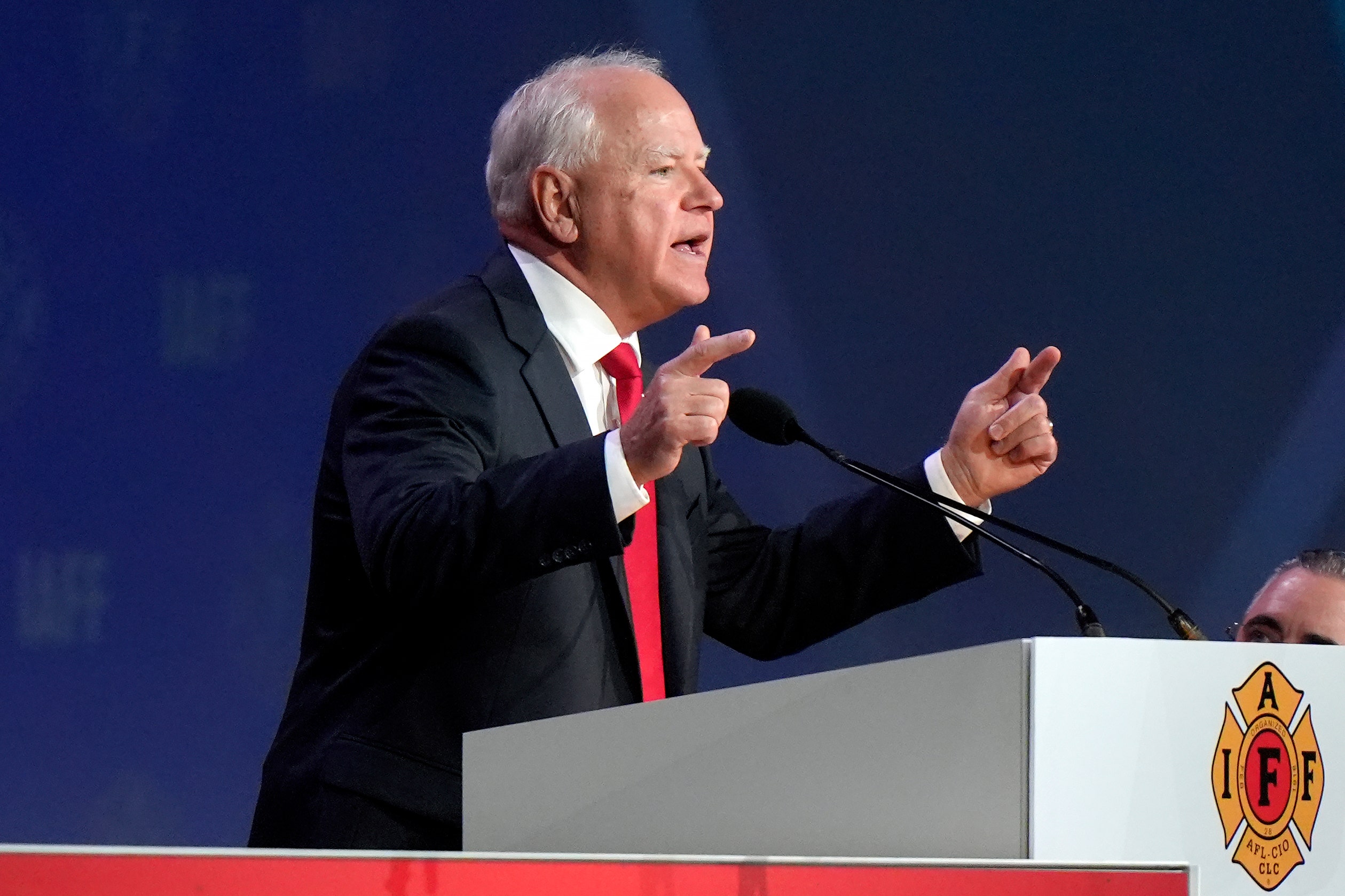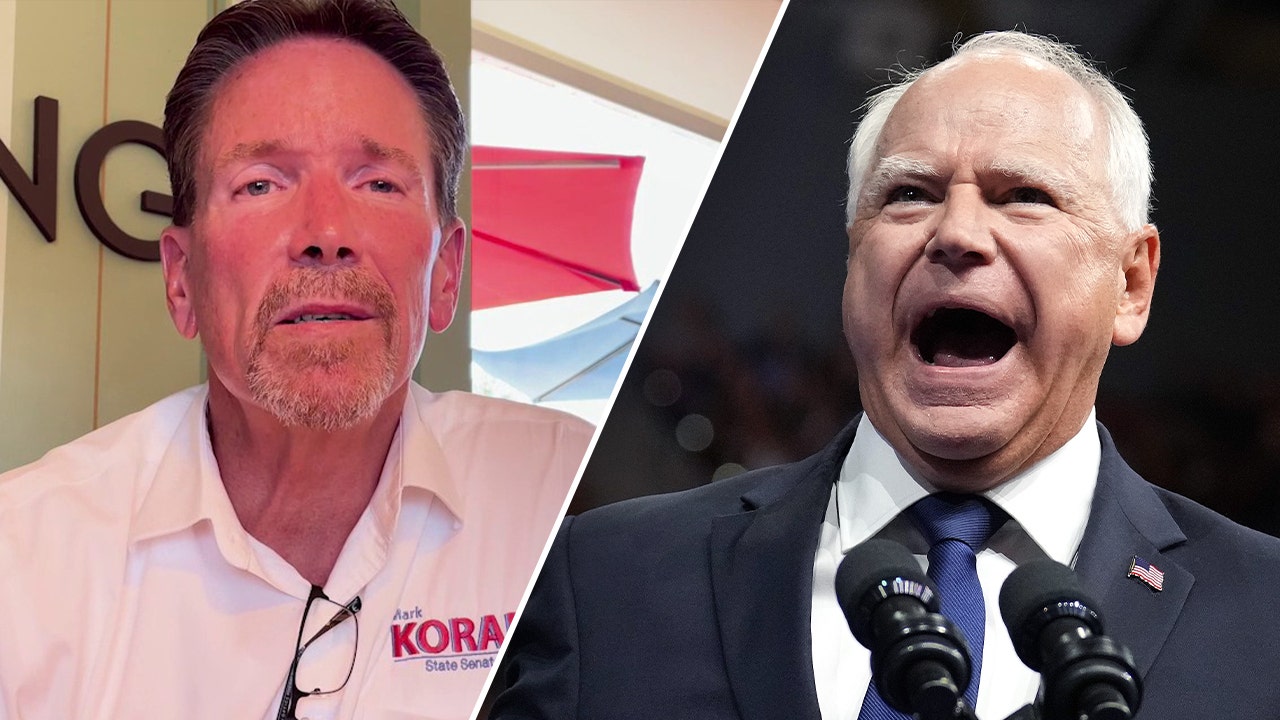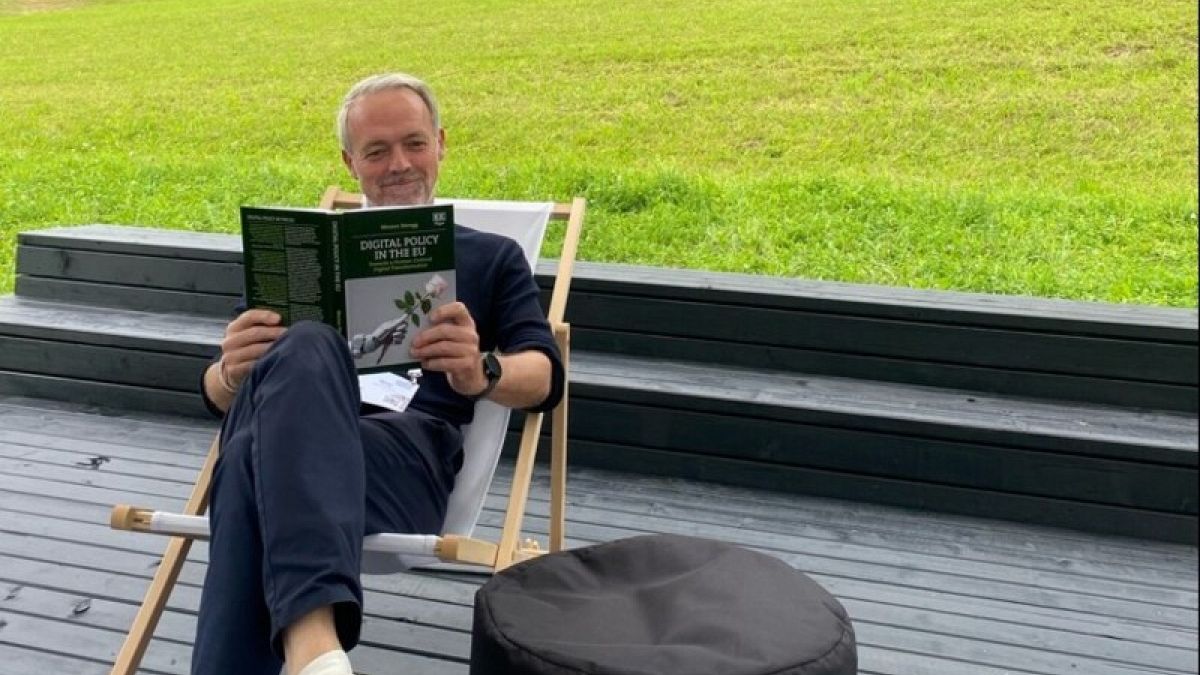Sports
US Open fan goes viral for awkward moment with woman during match: 'Pain'
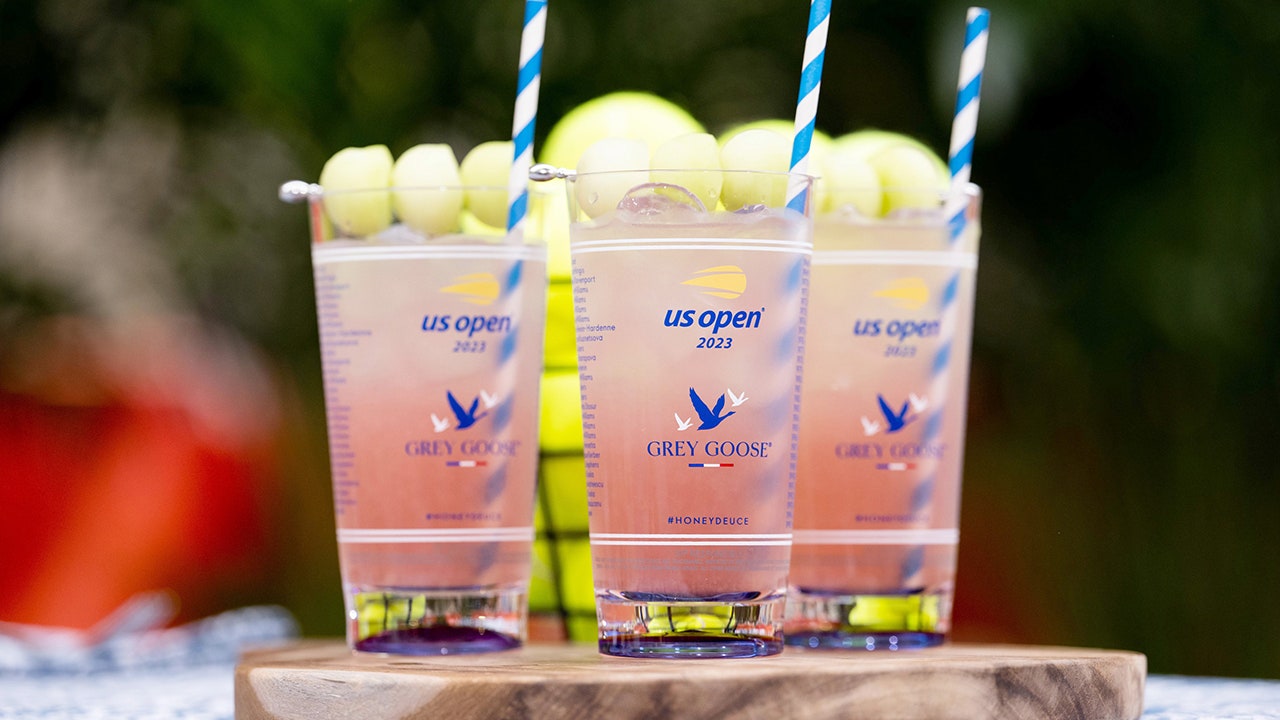
A U.S. Open fan’s awkward interaction in the stands during a match between Frances Tiafoe and Aleksandar Kovacevic went viral on Tuesday night and into Wednesday morning.
The cameras at Louis Armstrong Stadium had a break in the action when Tiafoe went up 30-0 on Kovacevic in the second set with the two competitors tied 1-1. The broadcast then showed a man returning to his seat with two Honey Deuce drinks – the signature cocktail of the U.S. Open. One of them was presumably for the woman sitting next to him.
US Open Honey Deuce Cocktail on Thursday, Aug. 24, 2023. (Nathan Congleton/NBC via Getty Images)
However, a man sitting behind him handed the same woman a cocktail – perhaps thwarting the man’s attempt to woo another bystander.
The moment quickly became a viral moment with sports fans talking about it on X.
Tiafoe won the match 6-4, 6-3, 4-6, 7-5.
The U.S. Open is one of the more interesting places where super viral moments have occurred recently.
US OPEN WINNER ANDRE AGASSI BELIEVES AMERICAN TENNIS IS POISED FOR GRAND SLAM ‘BREAKTHROUGH’ IN MEN’S SINGLES

Detail of Wilson tennis balls with the US Open logo during a practice session prior to the start of the 2024 US Open at USTA Billie Jean King National Tennis Center on Aug. 22, 2024 in the Flushing neighborhood of the Queens borough of New York City. (Sarah Stier/Getty Images)
On the court, Novak Djokovic was “defaulted” for hitting a linesman with a ball during a match. Serena Williams played her last matches at the Grand Slam event.
Off the court, Megan Lucky became a viral name when she showed off her beer-chugging skills at a few of the most recent U.S. Opens. She received some endorsement deals from the moment.
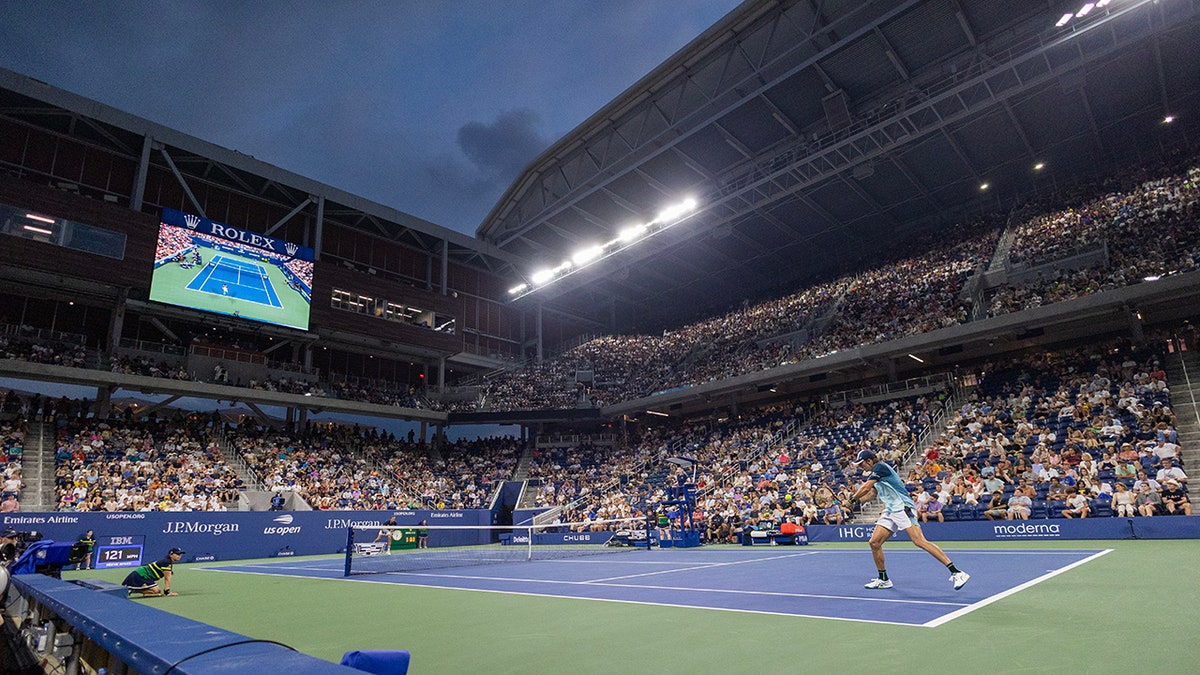
A general view of Alex de Minaur of Australia in action against Daniil Medvedev of Russia in the Men’s Singles round four match at Louis Armstrong Stadium during the U.S. Open Tennis Championship 2023 at the USTA National Tennis Centre on Sept. 4, 2023 in Flushing, Queens, New York City. (Tim Clayton/Corbis via Getty Images)
Alexa Greenfield also became a viral sensation when she dipped her chicken tenders into her soda. It earned her a signature sauce.
Follow Fox News Digital’s sports coverage on X, and subscribe to the Fox News Sports Huddle newsletter.

Sports
Explained: The Champions League draw, the Swiss Model and how selection is going digital

The Champions League proper returns next month and this season it will have a brand new format.
The ‘Swiss Model’ makes its debut and, as a result, the Champions League draw tomorrow (Thursday) is going to look rather different to the eight-groups-of-four setup we’ve all become used to in recent years.
So let The Athletic take you through everything you need to know about the draw and the new look for UEFA’s flagship club competition.
First, a quick recap. What is the Swiss Model and why are there so many teams now?
The new format has a ‘league phase’ rather than a ‘group phase’. It ditches eight groups of four and crams all the competing clubs together in one massive table. The format is based on the Swiss system used in chess, and does not require every team to play all of the others.
The number of teams participating increases by four, to 36, with each participant now playing eight matches in the first phase, instead of six in previous iterations. But instead of just three different opponents twice, home and away, teams will face a different team in every game.
In total, there will be 189 matches in the competition proper, capped by the final in Munich on May 31, up from the previous 125.
UEFA hopes the new format will lead to more competitive fixtures from the off, with bigger games earlier in the tournament because teams from pot one (aka, the big names) will play each other earlier rather than largely being kept apart until the knockout phase in February and March, as happened with the previous format. It will also give teams in pot four more of an opportunity to pick up points, because they will be playing two other sides from that pot among their eight matches.
Once the league phase has been completed, which will now take until late January, the top eight sides in the table will qualify directly for a 16-team knockout round, with the other eight places decided by a newly introduced set of two-leg play-offs contested by the teams who finish between ninth and 24th in the league.
The round of 16 and beyond will now be seeded, so the teams who finish first and second in the league phase cannot face each other until the final.
This season’s lineup will be completed tonight, with four clubs winning their places via the last of seven pre-tournament play-offs.
So how does this change the draw format?
Unlike previous years, where teams were drawn into eight groups from four pots, there will be four pots of nine this year, and they will all be seeded by coefficient. A club’s UEFA coefficient is a score based on the results of teams competing in the five previous seasons of the Champions League, Europa League and Conference League.
There’s one exception to that: the only club who won’t be seeded by coefficient are the Champions League title holders, in this case Real Madrid. They will be the first side drawn.
(Robert Michael/picture alliance via Getty Images)
Also, whereas last time every team was manually drawn, and there would be another manual draw to decide which group they would be put in, the draw will now be almost entirely automated.
All 36 teams will be manually drawn by someone on stage. But when a team come out of the ‘hat’, a button will be pressed and, hey presto, their eight opponents will appear. It will also say whether the team has been drawn to play at home or away (they’ll have four of each).
Each team will face two opponents from each pot, including two from the same one they are in.
This will be repeated until all 36 teams have been drawn. Every team will be drawn once but, as the process moves along, fewer sides will need to be assigned fixtures.
So can teams from the same nation face each other in the first phase now?
No. Or not this season, at least. It is no longer entirely impossible, in theory anyway. But the aim is to ensure that does not happen.
The new automated software will have to follow two UEFA rules. The first is that no club will face another from the same nation — unless there is the possibility of what is called a ‘deadlock’ situation; in other words, if it is impossible to avoid putting those teams together without stopping the draw. This is more likely to happen if one nation had a lot of clubs in the same pot, for example. But there is no risk of that for 2024-25.
The other rule is that it will only be possible to face a maximum of two teams from another association. So you won’t see Manchester City taking on all four Spanish qualifiers.

Manchester City’s group in last season’s draw (Valerio Pennicino – UEFA/UEFA via Getty Images)
Why has UEFA gone digital?
The main reason is to save time.
UEFA says that, if the entire draw was to be completed manually, around 1,000 balls would be spread across at least 36 bowls on stage and the whole process would take more than three hours.
Even digitally, drawing pot one is still expected to take 17 minutes.
“Based on rehearsals we have done, we are expecting some 35 minutes of a draw, which is exactly what he had before,” says Tobias Hedtstuck, UEFA’s head of club competitions and calendar, speaking at the body’s briefing on the new system for the media earlier this month.
That time does not factor in the draw’s presentation and sideshow events.
No changes there yet. Sorry about that.
Who is responsible for the software?
Now for the key question. Who has been crafting this mysterious technology?
UEFA has been working on this draw process for nearly a year. The software will be provided by AE Live, which was appointed as UEFA’s partner for all UEFA draws in September 2023 and tasked with developing and testing the software.
And what, you might ask, is AE Live? Well, it’s a company that works in live sport and provides graphic and technology solutions for the industry and has offices in eight countries.
“When it comes to our experience, we have our in-house teams which have a wealth of experience delivering live services across a range of sports, such as cricket, rugby, badminton and even kabaddi,” says Dave Gill, AE Live’s chief technology officer. “But we do have a particular strength in football, across both international and domestic competitions.”
AE Live has provided draw services for more than 20 years, including for the FA Cup, to FIFA, as well as for the International Olympic Committee and CAF, African football’s governing body. “We are very well qualified to provide this draw solution and to support UEFA in this exciting new development,” Gill says.
Global financial services company Ernst and Young has also been appointed to give an “extra layer of assurance and transparency”, according to Giorgio Marchetti, UEFA’s director of football and deputy general secretary. Ernst and Young have audited and monitored the development of the software, and its personnel will also observe and report on the draw operations itself.

Former England midfielder Joe Cole assists with the Champions League’s final manual draw last season (Claudio Lavenia – UEFA/UEFA via Getty Images)
And what happens if this software crashes?
There are fail-safes in place should issues arise, and also to ensure the draw remains feasible and there is no ‘deadlock’ scenario. That means the software has to ensure it’s still possible to find opponents for everyone else after a team is drawn. It assesses this itself when drawing opponents for a given club.
There are also two independent external checking systems.
“The role of these checking systems is to simply confirm what has already been established: that the rules of the draw have been followed and the draw remains feasible,” said Gordon Vince, chief software architect. “This checking takes no more than a second. As a result of that, we have extra confidence that the rules are being followed and that the draw remains feasible.
“Only then are the teams ready to be revealed.”
What about cyber-attacks?
AE Live says it is taking the risk of a cyber-attack seriously and has put several protections in place to keep the draw secure.
“The draw itself will be conducted in an entirely closed environment,” Gill says. “There will be no external access from external interference for a period of time before the draw and during the draw, so there’s no DDoS (distributed denial-of-service) attack (which can overwhelm the system and cause it to fail).
“Access to our code, and our code repository, are controlled through multi-factor identification. It’s a very limited amount of people who have access to our code. We’ve just conducted some penetration testing from an external third-party provider to make sure that we are, as a business, as secure as we can be. We’ve done additional risk assessments around the increased risk around cyber-attacks.”
Surely this fancy computer will be biased against (insert your club here)?
UEFA is also trying to ensure everyone feels comfortable with a process that is not visible, which could easily lead to conspiracy chatter.
“That’s why we appointed an external company (Ernst and Young),” says Marchetti, “to confirm not only that the software has been properly set up, and is purely random while respecting the couple of rules that we have, but also to observe the implementation and application of the software, as well as the procedures on the day of the draw.”
Ernst and Young staff will produce a report after the draw. In a statement, the company said: “In our opinion, in all material aspects, the software source code of AE Live selects and allocates football teams randomly and correctly, in accordance with the league-phase digital draw procedure defined by UEFA.”

Real Madrid’s Dani Carvajal brings out the Champions League trophy before the UEFA Super Cup win over Atalanta (Mikoaj Barbanell/SOPA Images/LightRocket via Getty Images)
What are the worst- and best-case scenarios for each club?
The final lineup for the draw won’t be confirmed until after those final four play-off second legs tonight, so only then will we know the final pot positions and risks for each of the 36 teams.
But we do have an idea about how likely it is that a club faces the hardest possible opponents (ie, the top two sides from each pot) and vice versa.
UEFA has estimated that the probability of either happening is 0.00006 per cent. UEFA says that in the previous iteration of the group stage, that probability was 0.2 per cent.
Doing it this way should make the league phase more competitive.
When will we find out the actual fixtures?
This is a key detail for those looking to book flights and hotels as early as possible.
The dates for the fixtures are not going to be released on the same day as the draw.
That information will be announced at some point on Saturday, August 31, in order to ensure the logistical and security dilemmas of the Europa League and Conference League, UEFA’s second- and third-tier club competitions can be taken into account, too.
“The opponents are selected pot after pot, but the order in which they are displayed does not mean the order of the (match) calendar,” says Marchetti. “The calendar will be decided based on different software; based on hundreds, if not thousands of constraints that we have, such as clubs who play in the same cities, or even the same stadium.”
Each team will play one game at home and one away against sides in each pot. UEFA is aiming to have a “fair and balanced split” between Tuesday and Wednesday matches as well, but this is not guaranteed.
UEFA also wants to spread out the competition’s “top matches”, for spectacle and sporting reasons.
“The key target is that in matchday one and two, or seven and eight, you (a club) should not play two pot-one teams in a row,” says Hedtstuck. “They should spread a little bit. We will try this for all 36 teams. The new system should have a more balanced calendar. Security constraints will have to be prioritised.”
How can we follow it?
The draw will be streamed live for free on UEFA’s website as well as broadcast on their broadcasting partner networks. Those will include TNT Sports in the UK and Paramount in the United States.
When and where is the draw?
The most important detail is saved until last.
The draw is to be held at the Grimaldi Forum, an exhibition centre in Monaco, on the south coast of France, and will be conducted at 5pm BST/12pm ET tomorrow (Thursday, August 29).
The Europa League and Conference League draws, both following the same 36-team format, happen there the following day at 12pm BST/7am ET and 1.30pm BST/8.30am ET respectively.
(Top photo: Rob Newell – CameraSport via Getty Images)
Sports
Column: Chase Williams leads St. Bernard's return for its first football game since 2021

From the football field at St. Bernard High in Playa del Rey, you can watch one jumbo jet after another taking off from LAX with a burst of engine thrust so loud that it feels like the ground is about to shake.
“You get used to it,” senior receiver Chase Williams said.
No teenager has demonstrated more skills to adjust and adapt to his environment than Williams. He showed up at St. Bernard in the fall of 2021 as the pandemic was ending. He wanted to be a multisport athlete playing football and baseball. He was welcomed with the news St. Bernard was dropping its football program after an exodus of players following the resignation of coach Manuel Douglas in the spring.
As the son of College Football Hall of Famer David Williams, a star receiver at Illinois and in the NFL, Chase decided to focus on baseball, becoming a starting center fielder as a freshman. Each year he was told St. Bernard would restart the football program. Twice the school hired new coaches. But nothing happened in 2021, 2022 or 2023.
“It’s traumatizing,” he said.
Last year the new school president, Casey Yeazel, a former principal at St. John Bosco, made a commitment to Williams.
“Chase, we’re going to have a football team. I promise,” Yeazel told him.
“Honestly, I didn’t believe him,” Williams said. “But it’s happening.”
Yeazel hired former Dorsey coach Charles Mincy. The program has close to 30 players and opens the season Friday night at Littlerock in the Antelope Valley.
Chase Williams has a 3.96 GPA and finally gets to play football at St. Bernard.
(Eric Sondheimer / Los Angeles Times)
“I’m excited,” said Williams, who hasn’t played football since he was a seventh-grader in 2019. “The hitting doesn’t faze me. My father prepared me a long time ago. You get the itch and now you have to go for it. Now it’s on us. Now it’s on the players and coaching staff to give people a show and prove something because we haven’t had a football team for three years.”
No one knows how talented Williams is in football, but there’s plenty of evidence he might be a keeper.
“He’s really good,” Mincy said.
Williams is 6 feet and 175 pounds, has a 3.96 grade-point average and said his father long ago taught him how to catch passes.
“If they get me the ball, I’ll do something with it,” he said.
He’s a shining example of the kind of student-athlete the new St. Bernard wants to attract. Besides a new president, the school has a new principal, new athletic director and other new coaches. Enrollment has dropped below 200, but the superintendent for Catholic Schools in Los Angeles has given marching orders to Yeazel to get St. Bernard back on track.
“It’s a jewel. We’ve got great kids,” Yeazel said.
St. Bernard soon will be surrounded by top athletic facilities through Lulu’s Place, a $150-million athletic and educational complex under construction nearby. It is hoped that will help lead to more students enrolling.
Williams is the go-to student at St. Bernard. Besides being an all-league center fielder — and an example for brother Brady, a highly regarded freshman baseball player — he was the announcer for the girls’ flag football team, and the theater teacher has been lobbying for him to show off his outgoing personality.
What kind of football season St. Bernard will have remains uncertain.
“We’ll do some smoke and mirrors to get things rolling,” Mincy said.
The video board that has stood largely unused for three years is supposed to be working when St. Bernard plays its first home game on Sept. 6.
“Everyone is excited,” Williams said. “My dad is finally going to get to see his son do his thing on the football field.”
Williams has no regrets showing loyalty to St. Bernard and staying for four years despite three with no football team.
“Patience is key,” he said. “But it’s easy to be patient when your environment is great. There’s nothing pushing you to leave because the education and school are great.”
Sports
At U.S. Open, Coco Gauff, Ben Shelton, Brandon Nakashima take care of business as New York expects

Follow live coverage of day two at the 2024 US Open
NEW YORK — A year ago, Ben Shelton started his U.S. Open on Court 10, in the quasi-hinterlands of the Billie Jean King National Tennis Center. To find it, walk over to the other side of the fountains, where a ball that flies over the back fence is basically gone forever.
First Monday a year later, he had a different assignment: opening up Arthur Ashe Stadium at high noon against Dominic Thiem, the 2020 champion and a player whom Shelton watched, jaw on the floor, through his teen years.
How much has Shelton’s life changed in a year?
“I just felt comfortable,” he said. “Used to it. Felt like I had been there before.”
He had indeed. The then-20-year-old played three matches in the biggest stadium in the sport last year, culminating in a semifinal duel with Novak Djokovic. That ended with the 24-time Grand Slam champion mocking Shelton’s hang-up-the-phone celebration, with Shelton staring Djokovic down during an icy handshake.
“After last year, the stage doesn’t get much bigger than that,” Shelton said.
Maybe. Or maybe it does.
For the first time since 1996, there are five men and five women from the U.S. in the top 20. Since none of the men is ranked higher than No. 12, it’s not exactly the glory years of Sampras, Agassi, Courier and Chang. No American man has won this event since Andy Roddick in 2003. But those top five women include Coco Gauff, the defending champion, and four others ranked no lower than Madison Keys at No. 14.
The hope is palpable. The grounds are teeming, with the metal bleachers and concrete gangways of the field courts packed with bodies, noise and expectation.
U.S. Open fans poured into the Billie Jean King National Tennis Center with a sense of genuine hope. (Frank Franklin II / Associated Press)
Shelton was batting leadoff for the bigger names in the top half of the draw, with Gauff coming on after him. She couldn’t rely on the calm and comfort that Shelton experienced as the opening act before he eased through a fading Thiem 6-4, 6-4, 6-2.

Ben Shelton is seeking to emulate his run to the semifinals in 2023. (Seth Wenig / Associated Press)
The last time Gauff played a competitive match here, she finished it flat on her back, with tears streaming down her face and 24,000 delirious fans screaming for her and everything she meant.
The 20-year-old doesn’t like to wave to crowds, because then she sees how many people are watching her. It makes her nervous. But Shelton gave her a jokingly hard time about it during a charity match in Fan Week, so Monday, she waved. Here come the butterflies.
Warming up calmed her down, but then she very nearly lost her serve in her first two attempts. Then she settled down, plowing through an even shakier Varvara Gracheva of France, 6-2, 6-0.
“I feel like I’m finding my game,” Gauff said when it was over.

She’s been shaky since losing in the semifinals of the French Open in June. Earlier than expected losses. On-court spats with coaches over errors and with chair umpires over calls. Her wins this summer have mostly come against players outside the top 50.
She’s No. 2 in the world. She knows she’s supposed to be better than that.
She lost early in Cincinnati, too, but then had a good week of practice, she said. In that time, she flipped the scenario around in her mind, telling herself that the early loss in Ohio, where she was the defending champion, had been a blessing in disguise. It gave her extra time to train, some flat track after the hamster wheel of the Olympics, Canada and Cincinnati.

Coco Gauff says she is settling into her game after a rough patch. (Fatih Aktas / Anadolu via Getty Images)
She walked onto Arthur Ashe on Monday believing that regardless of the scoreline, she would be able to find her game.
“Obviously, getting through the first round like this is good,” she said. “I’ve learned that how you start a tournament doesn’t mean how you’re necessarily going to finish and vice versa.”

GO DEEPER
‘Serena and Venus said I can be myself’: How U.S. tennis star power went from White to Black
True enough, but the first step is to survive the start. Taylor Fritz knows this better than just about anyone. Two years ago, he arrived in New York thinking he could actually win it.
Djokovic wasn’t playing because he refused to get vaccinated for COVID-19. Rafael Nadal was playing injured. Roger Federer was a month from retirement. Carlos Alcaraz was just a guy called Carlos Alcaraz, or about as close to that as he has ever been.
Fritz instead lost in the first round, to a qualifier named Brandon Holt. Holt is best known for being the son of Tracy Austin, a two-time champion a few generations back, and for beating Fritz at the U.S. Open in 2022 when Fritz thought he had a chance to actually win it.

Taylor Fritz used the momentum of a tight first set to ease past his opponent, Camilo Ugo Carabelli. (Fatih Aktas / Anadolu via Getty Images)
Fritz will think about that loss, and about the double-edge of a home Slam, at every U.S. Open and until he retires.
“It’s awesome to be playing at your home Slam with the crowd and just everything going on,” he said after a straight-sets win over Camilo Ugo Carabelli of Argentina.
Keys, the 2017 runner-up to another American, Sloane Stephens, joined the trio in taking care of business when she rolled through Czech doubles star Katerina Siniakova. Emma Navarro blasted Anna Blinkova, 6-1, 6-1.
Stephens was taking care of business, up 6-0, 3-0 on France’s Clara Burel, but then she faltered to lose 0-6, 7-5, 7-5.
There were some better American surprises. In her first main-draw match on the WTA Tour, 16-year-old wild card Iva Jovic beat Magda Linette of Poland, who is double her age and ranked 347 places higher.
Before the pandemic, Jovic played soccer and swam, an all-round athlete. But once COVID-19 arrived, tennis was the only sport she could pursue, since she didn’t have to be part of a team.
Now she’s the youngest American ever to win a main-draw match at the U.S. Open.

Iva Jovic defeated Magda Linette, who is ranked 347 places above her. (Robert Prange / Getty Images)
Linette figured to be a bit of a tall order, but Jovic had watched other juniors that she had beaten take out solid tour players in recent months. She convinced herself she had the level.
“I have nothing to compare it to, but it’s definitely nice for my first one to be in New York,” said Jovic, who played in front of a packed crowd on Court 15 that could have turned other teen knees to goo.
Then there was Taylor Townsend, the Wimbledon doubles champion, leaning into her status as a big-serving lefty nightmare on the singles court.
“This isn’t an all-of-a-sudden thing,” Townsend said after beating Martina Trevisan of Italy.
“The success that I had in doubles and the understanding of the self is translating now onto the singles court.”

Taylor Townsend’s best singles run in New York was a fourth-round appearance in 2019. (Jamie Squire / Getty Images)
Another surprise? Brandon Nakashima blasting Holger Rune, the No. 15 seed, 6-2, 6-1, 6-4 in a tidy hour and 55 minutes. Throw in Rune’s recent form, and Nakashima’s propensity to lull opponents into errors, and it’s not exactly a big one.
Then came Frances Tiafoe, who had a night slot at Louis Armstrong Stadium. This is the tournament for which he spends 50 weeks each year counting the days, and he has said, with only the slightest bit of sarcasm, that it’s one of just two that he really cares about.
The Citi Open in Washington, D.C., is the other, but nothing compares to his home Grand Slam. That can be a double-edged sword, as for Fritz.
“I’m so amped up,” Tiafoe said last week. That too can have both advantages and disadvantages, and he knows it. New coach David Witt’s reputation as one of the more laid-back souls in the game is one of the reasons Tiafoe hired him.
“I can get really high and pretty low, and he keeps me even-keeled,” he said. “Not allowing moments to be bigger than they are, or to be as strenuous as I can sometimes make them.”

Frances Tiafoe is beginning to look more like himself after a difficult first six months of the year. (Kena Betancur / AFP via Getty Images)
Come showtime, Tiafoe was doing his thing, with plenty of the whippy forehands and touch volleys that can make him a human highlight reel when he is on. On is what he was for much of the night, which ended in a four-set win over another American, Alex Kovacevic.
Tiafoe wobbled a bit in the third set, failing to put away Kovacevic with the efficiency he will need if he wants to get back to the second week.
“Got pretty tough there at the end,” Tiafoe said.
On the always nervy opening night at the home Slam, it was enough to take care of business.
(Top photo of Brandon Nakashima: Matt Rourke / Associated Press)
-
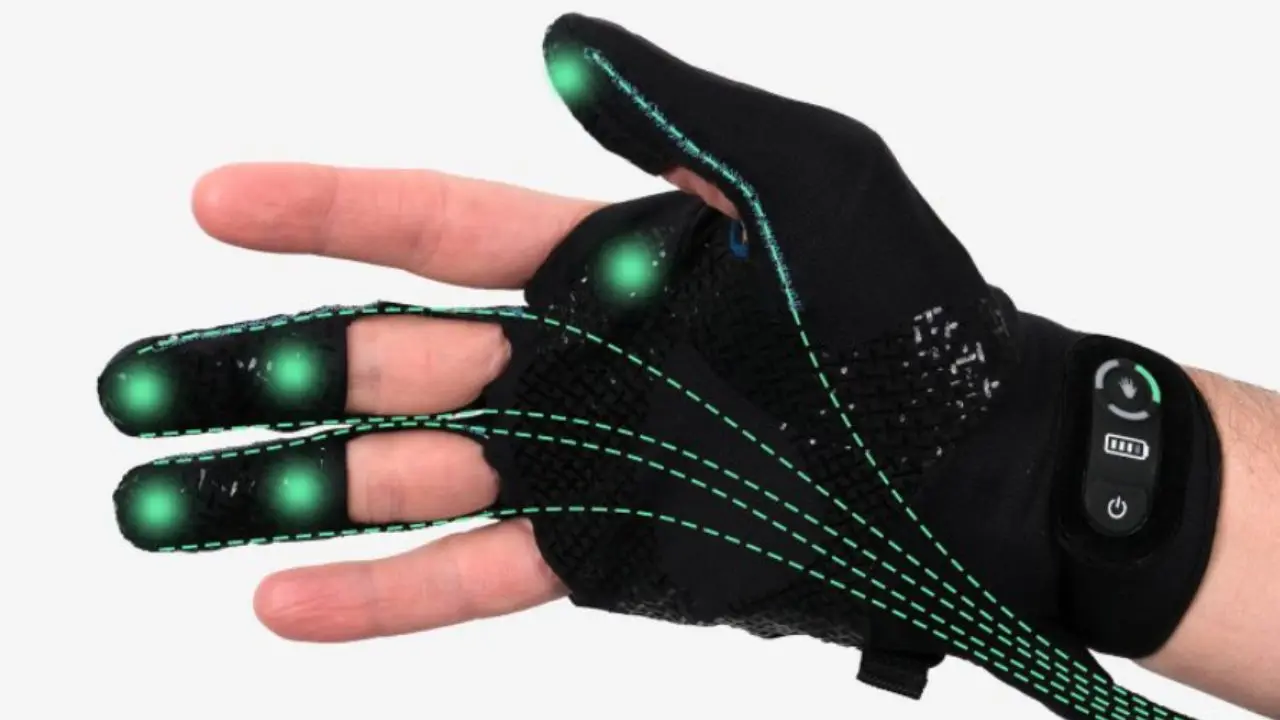
 Technology6 days ago
Technology6 days agoBreakthrough robo-glove gives you superhuman grip
-

 Connecticut5 days ago
Connecticut5 days agoOxford church provides sanctuary during Sunday's damaging storm
-

 News1 week ago
News1 week agoVideo: Biden Delivers Keynote on First Night of D.N.C.
-

 News1 week ago
News1 week agoVideo: Protesters Clash With Police Near the Democratic National Convention
-
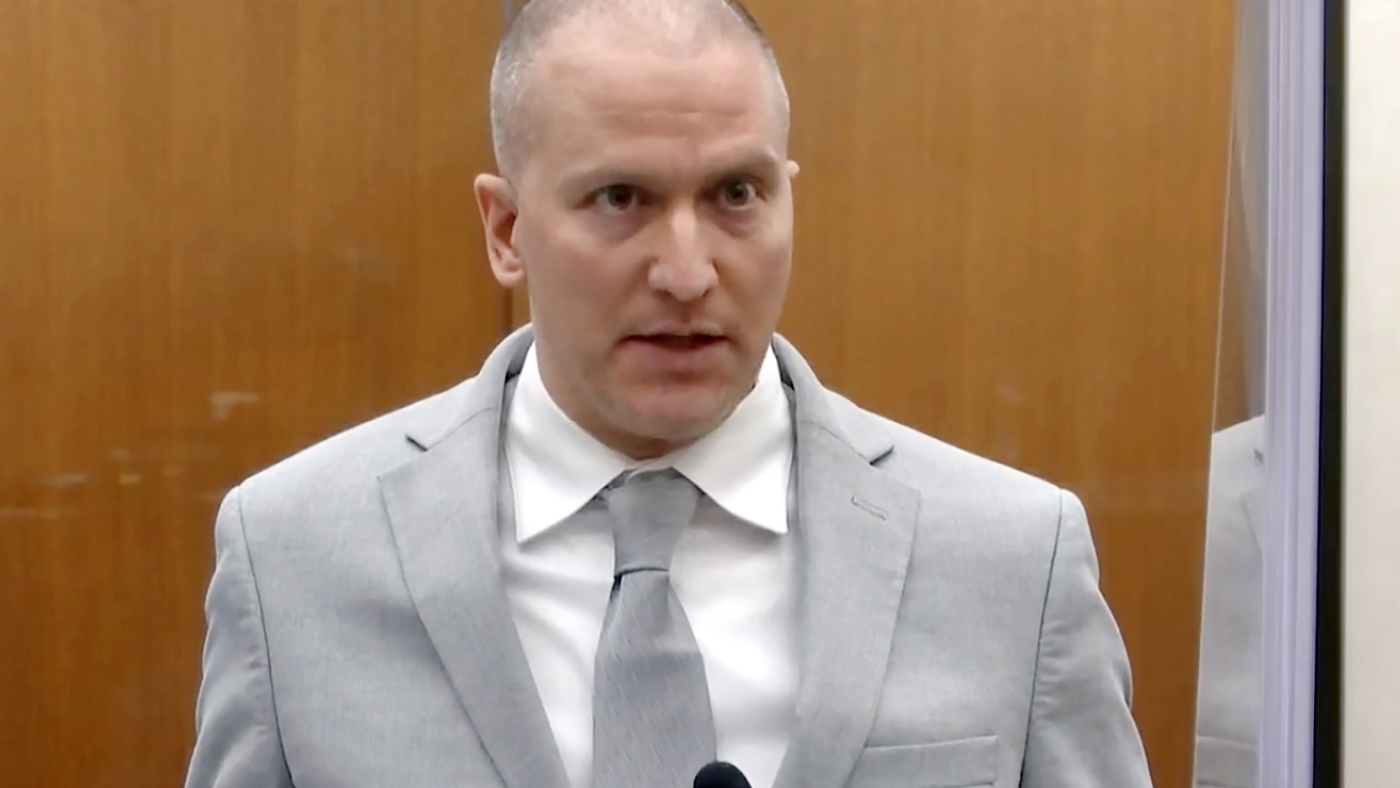
 News1 week ago
News1 week agoEx-officer convicted in George Floyd's killing is moved to new prison
-
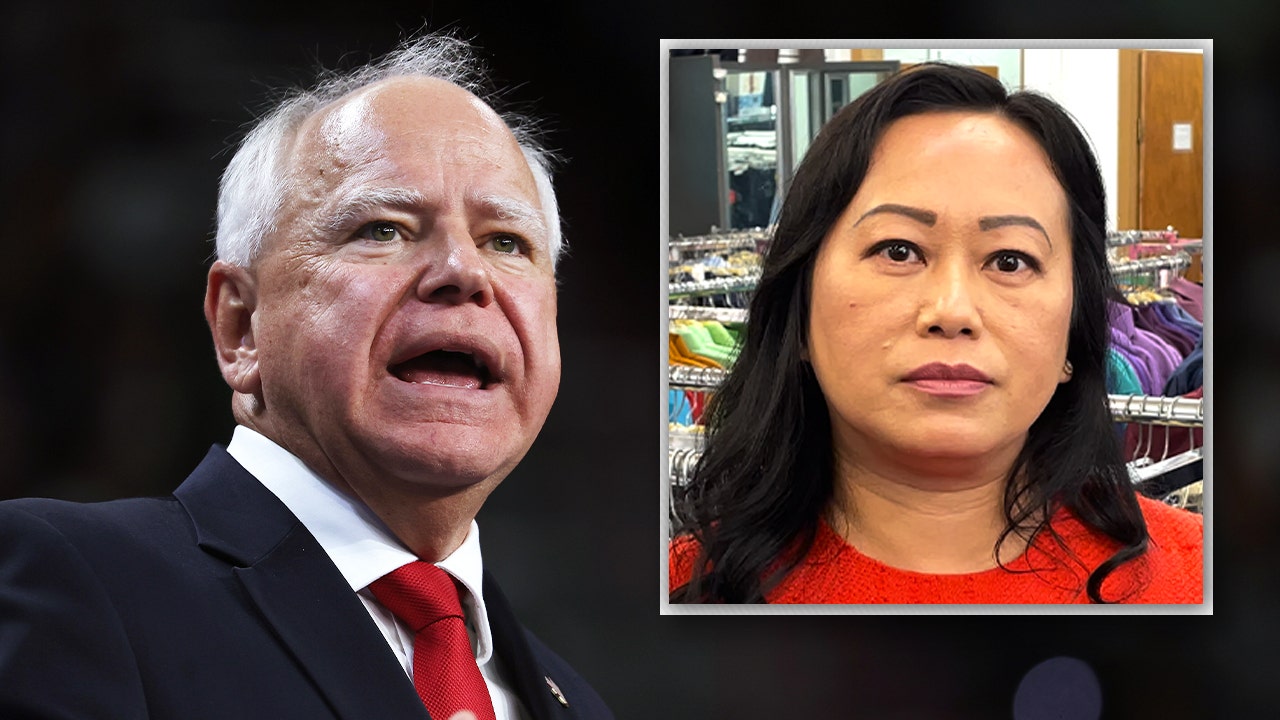
 Politics1 week ago
Politics1 week agoFormer teacher reveals which students suffered 'the most' under Walz's pandemic-era guidelines
-

 News1 week ago
News1 week agoVideo: D.N.C. Holds Enthusiastic Roll Call to Nominate Harris
-

 World1 week ago
World1 week agoPanama deports 29 Colombian migrants from Darien Gap under US deal









